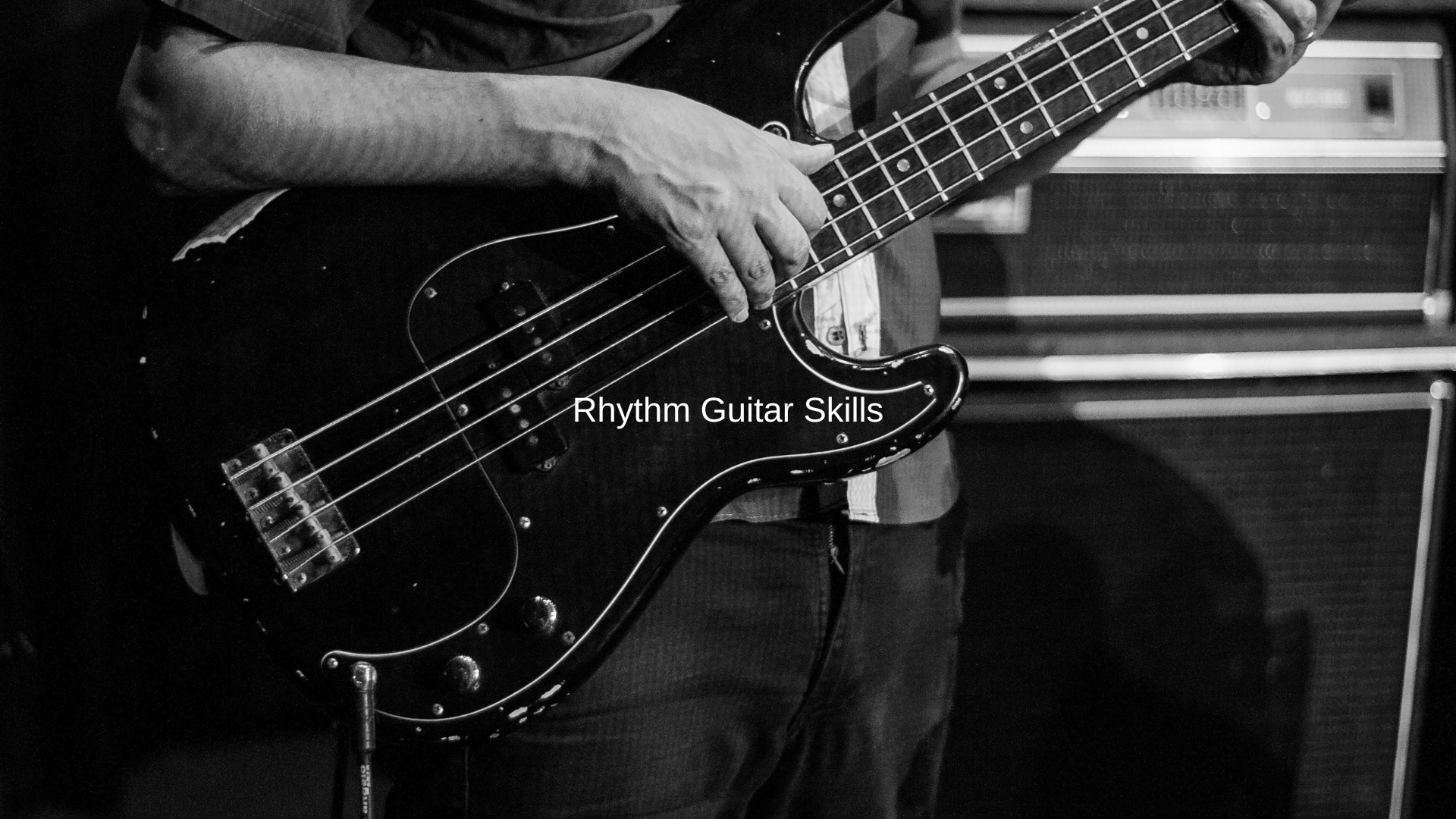How to Get Better at Guitar Rhythm?
Music has three components. Harmony, melody, and rhythm are examples of these. Harmony includes things like chords and when more than two notes are performed at the same time. Melody encompasses riffs, lead ideas, and everything hummable. The term “rhythm” is self-explanatory.
All are crucial, but rhythm encompasses all you can ever accomplish in music. I usually say rhythm is the most important.
So, why do 99% of guitar materials and instructors never teach anything about rhythm? Things are improving. However, there is an unusual emphasis on harmony and its topics, such as chord playing, chord voicing, and triads. There is also a strong focus on melody, particularly on scales, but not on how to apply excellent, sexy, tight, and snappy grooves to the preceding.
Rhythm guitarists are the real heroes of rock. Outstanding rhythm guitarists (think Malcolm Young, Izzy Stradlin, Brad Whitford, and others) have been underappreciated for decades. While rhythm guitarists may not appear on magazine covers as frequently as lead guitarists, they are a crucial component of the original Rock and Roll formula.
It’s a common misperception that you must be either a Lead or Rhythm Guitarist. The designations “lead” and “rhythm” are nearly entirely obsolete in modern music. Most performers do a little bit of both, depending on the tune. Even then, performers like Hendrix and SRV blurred the distinction between lead and rhythm playing.
Today, if you want to be a great guitarist, you must be a great rhythm and lead guitarist. So, without further ado, here’s how to improve your rhythm guitar skills.
Why Rhythm and Strumming Are So Important?
The unpleasant truth is that strumming distinguishes great guitarists from ordinary guitarists. Few people recognize that strong strumming is essential to being a competent guitarist.
You can play all of the fundamental chords and even more difficult ones. But they’re meaningless if you can’t make them sound decent. A C#madd9, or a Cmaj for that matter, will not sound well without a suitable strumming pattern.
Strumming is, in my opinion, one of the most challenging obstacles for newcomers to overcome. If your strumming is stiff and unnatural, people will judge you as a novice in about half a second. So this post is all about overcoming that obstacle.
Ways to Improve Your Rhythm and Strumming
We’ll go through some tried-and-true methods for improving your guitar rhythm and strumming. As long as you adhere to these approaches and practice every day, you’ll see an improvement in yourself.
1. Become A Music Student
The art of rhythm guitar lies in bringing the drummer, bassist, lead guitarist, and singer together to make the ensemble seem crisp, tight, and cohesive. Consider it a bridge between melodic leads (vocals, synthesizers, or lead guitar) and the typical rhythm section (drums, bass, and piano in some genres). If the rhythm guitar is off, these two sections will appear out of sync, but if played correctly, it may conceal any out-of-sync and make the entire band feel perfectly together.
That means a great rhythm guitarist must have a good ear and comprehend what’s going on with each instrument in the band, both rhythmically and melodically. To do so, you must listen to everything you can—even genres you don’t usually play in—and not just hear it but also listen to how the various instruments interact with one another.
A skilled rhythm guitarist must swiftly examine what notes, scales, and chords everyone is utilizing to link everyone’s thoughts and skills. You won’t be able to grasp which notes and chords mix smoothly into a tune unless you have a solid understanding of music theory.
2. Always Put Timing First
Learning to play rhythm guitar might be difficult. You are the backbone of your band, along with the drums and bass, and your time and feel must be impeccable. That is why you must train to be a rhythm machine. While it is unrealistic to expect everyone to practice eight hours a day, if you want to be great, you will need to play fairly consistently in order to build a strong and accurate sense of rhythm.
I recommend using a metronome to practice playing the same beats at different BPMs to improve your time. This will let you adapt to diverse genres and tempos in the future, and it will ensure that you naturally focus on note timing in dynamic settings.
Being a superb rhythm guitarist is like being the band’s anchor. Nobody is flawless, yet thousands of people have learned to play rhythm guitar with outstanding timing throughout music history.
Practice with Metronome
If you want to be a guitarist who stands out in the way they play their instrument, you and the metronome must become close friends.
The good news is that after some practice with a click, you will achieve what I term “Robotic Perfection.” You will be able to play with an even pulse even if you are not using a metronome as a consequence of your efforts.
A drum machine is an alternative to utilizing a click. If training with a click feels like pulling teeth, this is your best alternative. The main goal of utilizing a metronome or drum machine is to provide advice as you, the musician, perfect your time. Keep in mind that you are what you practice. If you want perfect time, you must practice good timing, and a metronome is a tool that will provide you with such timing.
3. Record Yourself A lot While Practicing
Have you ever crafted an awesome lick only to forget it the next time you picked up your guitar, or built an incredible groove with the band only to forget its timing and accurate beat the next time you picked up your instrument? Documenting your sessions is the ideal answer for permanently removing that feeling—but remembering your most significant bits is only the tip of the iceberg when recording practice sessions.
Recording band sessions allows you to analyze and enhance how well you mix with your band, and it’s a great spot to hear your band from afar. Having the opportunity to stand back and concentrate on your time and methods to highlight what the rest of the band is doing can significantly boost your advancement as a rhythm guitarist. Spending a couple of hours a week on this can help you progress as a guitarist and bandmate.
The advantage of recording oneself is that it does not lie to you. It is a type of constructive feedback provided by a machine rather than a person! If you can always line up with the grid, you’re on your way to becoming a “groove machine.”
4. Play with Other Musicians
If you’re a new guitarist, the earlier you can start jamming with other musicians—whether it’s just a casual jam session or creating a genuine band—the better. The more people you can practice with, the better you’ll get as a musician progresses.
Even if you’ve played professionally for years, you don’t want to become accustomed to simply knowing how to perform with your primary band. Sitting in with other guitarists is the most straightforward and most enjoyable method to keep your chops sharp.
When you jam with somebody, you often begin with a chord pattern or riff that you repeat, and then you may take turns improvising solos. The ability to keep the riff continuing with precise timing has proven to be the most critical factor.
If you want to enhance your rhythm on guitar, one of the simplest methods to add life to your playing and keep listeners engaged is to use dynamics. When playing with another musician, try to pick up on their dynamics and find out what they’re trying to say via their music.
5. Play with Various Rhythmic Patterns
It’s human nature to get into a routine. We play specific rhythmic patterns because they are reinforced via repetition – through the music we listen to and play regularly.
Just because the bassist is performing an eighth-note beat doesn’t mean you ought to, and just because the band is performing straightforward doesn’t mean you can’t even throw in some syncopation.
As a guitarist, you can only control three variables:
- The notes you play (scale, key signature, etc.).
- How you perform them (rhythm).
- How quickly you can play the notes (tempo).
What many guitarists overlook is that rhythm is more critical than note choice. Take a moment to consider this. If you play three different scales with the same beat, they will sound somewhat different, but because the rhythm hasn’t changed, they will sound like a persistent drone.
Meanwhile, diverse rhythms define various styles and genres. Even if you played the identical notes orchards, the rhythmic pattern would specify if you played jazz, blues, rock, country, or anything else.
So, my advice here is to play around with different beats. Don’t push anything into a song, but also don’t settle for what’s comfortable and expected.
6. Listen to the Great Rhythm Guitarists and Play Along
Chuck Berry, Jimi Hendrix, James Hetfield, and Stevie Ray Vaughan are a handful of the legendary rhythm guitarists throughout history. Playing along with these guitarists may be difficult. However, understanding how they blend their notes and rhythms with the band will give you a lead to enhancement for becoming a great rhythm guitarist. It will show you how to perform rhythm guitar even better if you’re already reasonably decent.
Practicing songs you enjoy is an excellent approach to learning. You’ll usually have to learn new styles and methods in order to play some of your favorite tracks, which beats studying a skill for the sake of learning a technique. But don’t limit yourself to the style you’re most comfortable with. Practicing diverse types of music will teach you to employ different keys and meters, allowing you to be more innovative and imaginative in your chosen genre.
7. Practice Makes Perfect
As you begin to hone your rhythm guitar talents, your primary aim will be to make playing outstanding rhythm guitar second nature.
Playing is the only way to grow, and you may practice in various enjoyable ways. Playing a little bit each day can help you automate your motor skills if it is feasible. Even a five to ten-minute morning picking practice will make you a better player than you would be otherwise.
You may even practice a few skills while watching TV in the evening. The reality is that the more we practice, the more natural it will seem when we play.
The idea is to make practice enjoyable. Sometimes that means abandoning complex skills in favor of rocking out to your favorite songs. While other times, it involves breaking out of your comfort zone and trying a new genre. Variety is essential; above all, ensure you’re having fun. If things start to get boring, switch things up.
Final Thoughts
Here are some significant ideas for growing as a rhythm guitarist that you may include in your daily practice. Getting caught up in various practice routines that aren’t geared to improve certain aspects of your technique is easy.
To improve as a rhythm guitarist, we must modify our thinking about how we practice. So that we may enhance our rhythmic technique rather than focusing on things like “ear training” or “learning the fretboard.”
I’m not saying you shouldn’t work on these things. But if you want to get better at rhythm guitar, you must develop a practice program.
Rhythm is half the music; thus, you’ve already won half the battle by knowing it. Playing one note with excellent rhythm and timing is preferable to playing many notes with poor rhythm. Everything else will come apart if the rhythm fails. Please feel free to return and review this article anytime you need to.


